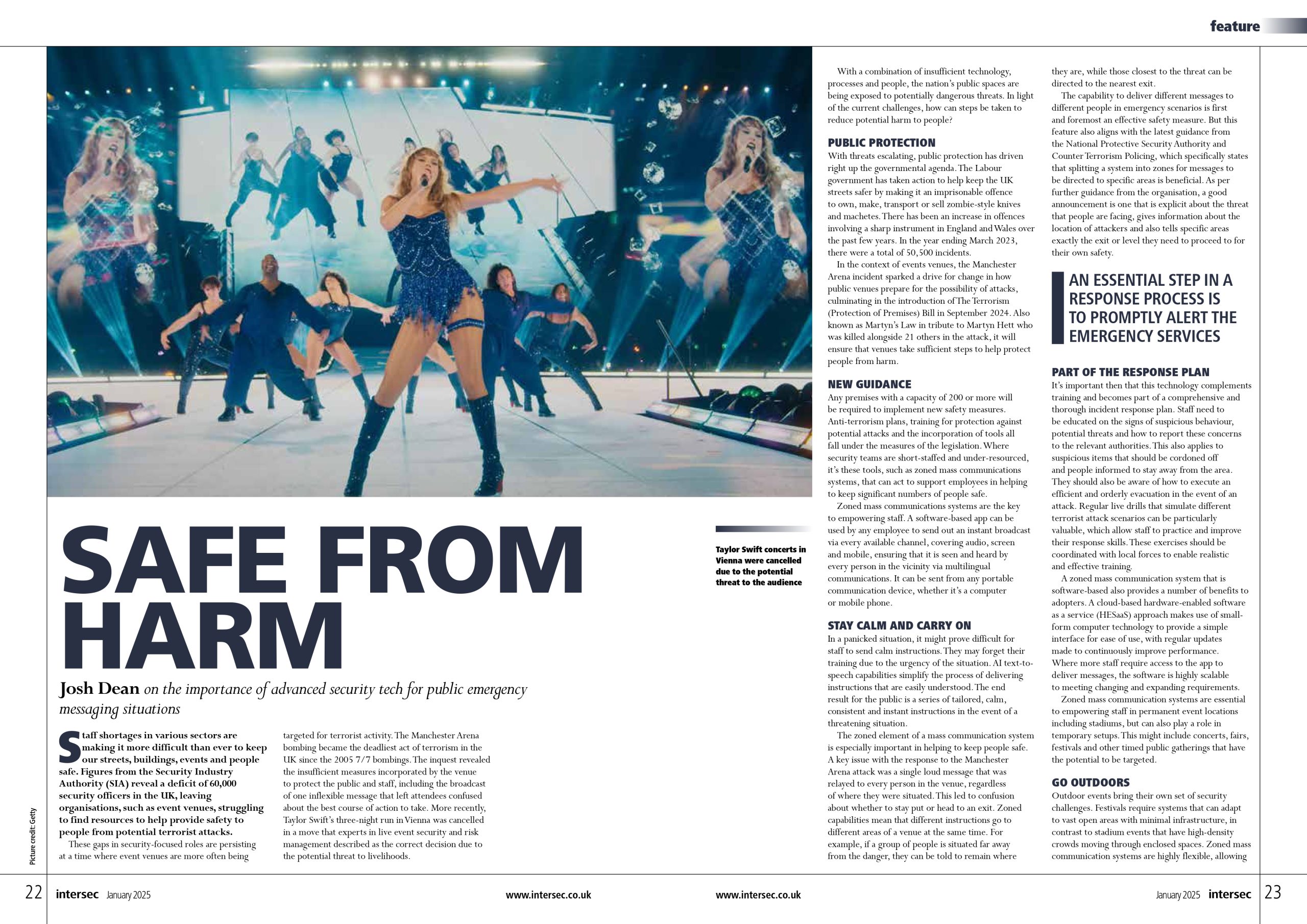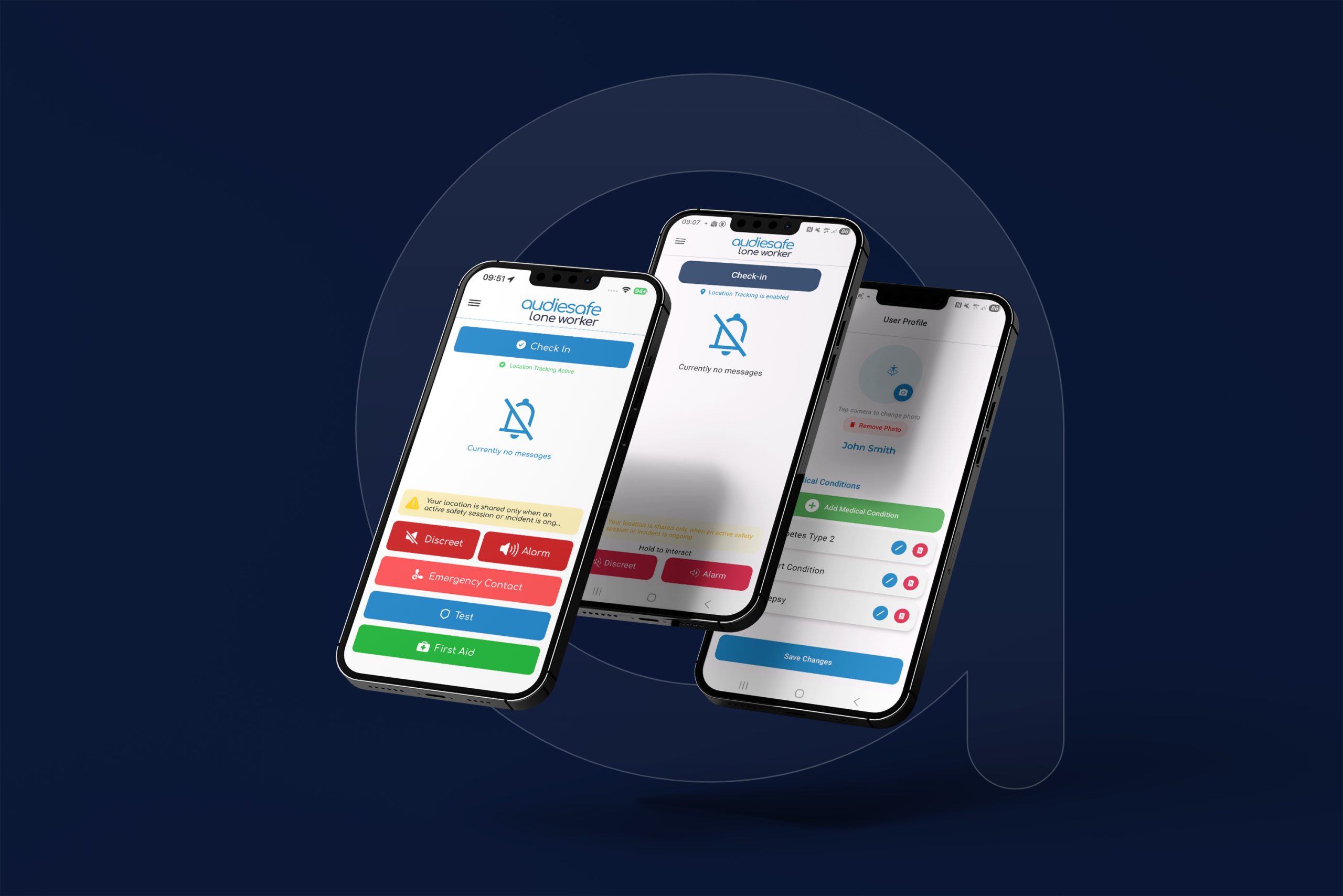We’re proud to share that our CEO, Josh Dean, has been featured in the latest issue of Intersec, a leading publication for international security professionals.
In the article titled “Safe from Harm”, Josh discusses the growing challenges facing public safety in the context of increasing threats and staff shortages across key sectors like venue security and emergency response. The piece explores how zoned mass communication systems — like those developed by Audiebant — can offer a scalable, powerful solution.
With new legislative measures like Martyn’s Law coming into effect, the pressure on venues, educational establishments, healthcare sectors and public spaces to be better prepared has never been greater. The Intersec article highlights how AI-enhanced, multilingual communication systems can bridge the gap—supporting short-staffed teams, enhancing emergency readiness and ultimately saving lives.
At Audiebant, we’re committed to helping organisations protect people and places with the smartest, most reliable tools available. If you haven’t already explored how our technology can support your team—now’s the time.
📰 Read the full article below to learn more about the future of emergency communication:
Safe from harm
Josh Dean on the importance of advanced security tech for public emergency messaging situations.
Staff shortages in various sectors are making it more difficult than ever to keep our streets, buildings, events and people safe. Figures from the Security Industry Authority (SIA) reveal a deficit of 60,000 security officers in the UK, leaving organisations, such as event venues, struggling to find resources to help provide safety to people from potential terrorist attacks.
These gaps in security-focused roles are persisting at a time where event venues are more often being targeted for terrorist activity. The Manchester Arena bombing became the deadliest act of terrorism in the UK since the 2005 7/7 bombings. The inquest revealed the insufficient measures incorporated by the venue to protect the public and staff, including the broadcast of one inflexible message that left attendees confused about the best course of action to take. More recently, Taylor Swift’s three-night run in Vienna was cancelled in a move that experts in live event security and risk management described as the correct decision due to the potential threat to livelihoods.
With a combination of insufficient technology, processes and people, the nation’s public spaces are being exposed to potentially dangerous threats. In light of the current challenges, how can steps be taken to reduce potential harm to people?
PUBLIC PROTECTION
With threats escalating, public protection has driven right up the governmental agenda. The Labour government has taken action to help keep the UK streets safer by making it an imprisonable offence to own, make, transport or sell zombie-style knives and machetes. There has been an increase in offences involving a sharp instrument in England and Wales over the past few years. In the year ending March 2023, there were a total of 50,500 incidents.
In the context of events venues, the Manchester Arena incident sparked a drive for change in how public venues prepare for the possibility of attacks, culminating in the introduction of The Terrorism (Protection of Premises) Bill in September 2024. Also known as Martyn’s Law in tribute to Martyn Hett who was killed alongside 21 others in the attack, it will ensure that venues take sufficient steps to help protect people from harm.
NEW GUIDANCE
Any premises with a capacity of 200 or more will be required to implement new safety measures. Anti-terrorism plans, training for protection against potential attacks and the incorporation of tools all fall under the measures of the legislation. Where security teams are short-staffed and under-resourced, it’s these tools, such as zoned mass communications systems, that can act to support employees in helping to keep significant numbers of people safe.
Zoned mass communications systems are the key to empowering staff. A software-based app can be used by any employee to send out an instant broadcast via every available channel, covering audio, screen and mobile, ensuring that it is seen and heard by every person in the vicinity via multilingual communications. It can be sent from any portable communication device, whether it’s a computer or mobile phone.
STAY CALM AND CARRY ON
In a panicked situation, it might prove difficult for staff to send calm instructions. They may forget their training due to the urgency of the situation. AI text-tospeech capabilities simplify the process of delivering instructions that are easily understood. The end result for the public is a series of tailored, calm, consistent and instant instructions in the event of a threatening situation.
The zoned element of a mass communication system is especially important in helping to keep people safe. A key issue with the response to the Manchester Arena attack was a single loud message that was relayed to every person in the venue, regardless of where they were situated. This led to confusion about whether to stay put or head to an exit. Zoned capabilities mean that different instructions go to different areas of a venue at the same time. For example, if a group of people is situated far away from the danger, they can be told to remain where they are, while those closest to the threat can be directed to the nearest exit.
The capability to deliver different messages to different people in emergency scenarios is first and foremost an effective safety measure. But this feature also aligns with the latest guidance from the National Protective Security Authority and Counter Terrorism Policing, which specifically states that splitting a system into zones for messages to be directed to specific areas is beneficial. As per further guidance from the organisation, a good announcement is one that is explicit about the threat that people are facing, gives information about the location of attackers and also tells specific areas exactly the exit or level they need to proceed to for their own safety.
PART OF THE RESPONSE PLAN
It’s important then that this technology complements training and becomes part of a comprehensive and thorough incident response plan. Staff need to be educated on the signs of suspicious behaviour, potential threats and how to report these concerns to the relevant authorities. This also applies to suspicious items that should be cordoned off and people informed to stay away from the area. They should also be aware of how to execute an efficient and orderly evacuation in the event of an attack. Regular live drills that simulate different terrorist attack scenarios can be particularly valuable, which allow staff to practice and improve their response skills. These exercises should be coordinated with local forces to enable realistic and effective training.
A zoned mass communication system that is software-based also provides a number of benefits to adopters. A cloud-based hardware-enabled software as a service (HESaaS) approach makes use of smallform computer technology to provide a simple interface for ease of use, with regular updates made to continuously improve performance. Where more staff require access to the app to deliver messages, the software is highly scalable to meeting changing and expanding requirements.
Zoned mass communication systems are essential to empowering staff in permanent event locations including stadiums, but can also play a role in temporary setups. This might include concerts, fairs, festivals and other timed public gatherings that have the potential to be targeted.
GO OUTDOORS
Outdoor events bring their own set of security challenges. Festivals require systems that can adapt to vast open areas with minimal infrastructure, in contrast to stadium events that have high-density crowds moving through enclosed spaces. Zoned mass communication systems are highly flexible, allowing staff to adapt safety measures to the specific layout and nature of each event.
Outdoor events often make use of tannoys and PA systems, which also possess the disadvantage of only delivering a single message to every attendee. Battery-powered zoned mass communication systems can offer all of the same benefits to staff and the public, without the worry of relying on mains power for it to work. Solar energy, even in low-light conditions, can provide the sufficient power for an adaptable, resilient and cost-effective solution. The technology can be transported to even the most remote locations to help provide safety to attendees.
Event organisers will want to prioritise safety in all aspects, not just for helping to protect people from terrorist attacks. For example, crowd control measures are important to avoid the risk of crushing in busy areas. Security staff can only do so much to mitigate the risk. It’s also important that cars are not parked illegally, so messages are important to inform people to disperse from an area or move their cars to more appropriate locations.
Whether at a venue or in a public space, an essential step in a response process is to alert the emergency services. Zoned mass communication technology innovations are supporting staff by allowing for automatic lockdown and information notifications to be sent to the relevant authorities, enabling them to arrive at the soonest possible moment in the event of an incident.
Outside of events spaces, the police and other emergency services also need support as force numbers continue to remain low. In an ideal world, our police officers should be on the front line to both reassure the public and take action if a crime occurs, but staff shortages mean that this isn’t always the case. There are opportunities for zoned mass communication systems to be installed in town centres and high footfall areas so that reassurance messages and general safety guidance can be delivered to the public.
Police and other emergency services can even be supported in emergency scenarios. If a terror attack takes place at one end of a high street, people in the immediate vicinity can be instructed to leave the area as soon as practically possible. A different instruction can then be delivered to those who are safely away from the danger to stay clear of the area.
Addressing the gaps caused by staff shortages is essential to safeguarding public spaces, events and venues from growing threats. While the lack of personnel is a significant challenge, advanced technology such as zoned mass communication systems offers a powerful solution to mitigate these risks. By empowering staff with scalable, adaptable tools, such systems ensure that timely, clear and tailored messages reach the right people in emergency situations.
In addition, the introduction of legislative measures such as Martyn’s Law reflects a proactive effort to push for better preparedness across event venues and public spaces. Technology must be integrated with comprehensive safety protocols, training and the cooperation of emergency services. Regular coordination exercises, joint simulations and information sharing between venues and police forces can greatly enhance preparedness.
In the face of increasing risks and dwindling security resources, zoned mass communication systems can provide the solution for organisations seeking to protect their visitors, employees and the public. With careful implementation, these systems can become the backbone of a more resilient, efficient and responsive security framework for the future.




